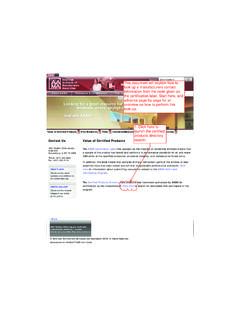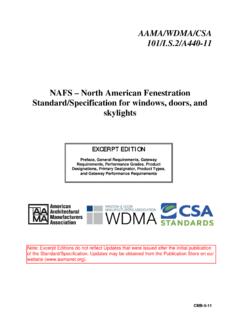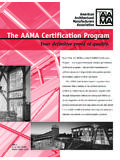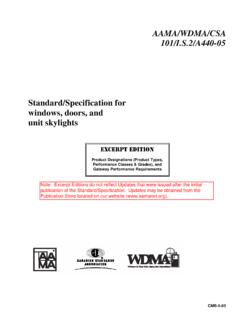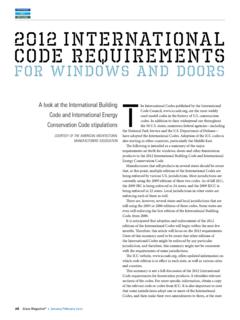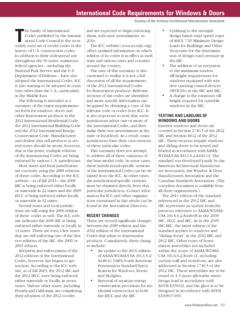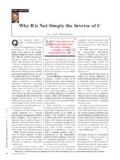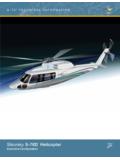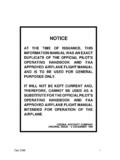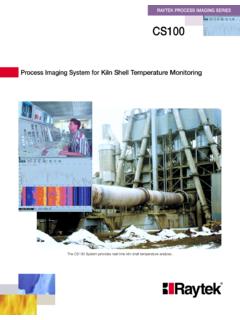Transcription of Differences in Design Pressure and Performance …
1 Door& to Some BasicsDifferences in Design Pressure and Performance GradeB Y K E N B R E N D E NFenestration products areundeniably becoming morecomplex as performanceexpectations diversify and same is true of the standardsthat guide those who Design andspecify these products. The lynch-pin of these standards is theAAMA/WDMA/CSA 101 , The North AmericanFenestration Standard/Specification[NAFS] for Windows, Doors andSkylights, the latest version ofwhich is 2008 although the 2011version is waiting in the wings foradoption into the 2012 is apparent widespreadmisuse of certain NAFS perform-ance terms within the industry,especially Design Pressure per-formance class and performancegrade.
2 At times, marketplace con-fusion has led to specifying thewrong product for a given build-ing application. Design PressureRecall that wind force is theprimary source of structuralloading on an installed door orwindow. Wind exerts pressuredirectly proportional to thesquare of the wind Pressure thus serves to localize a Design for the windloading expected at the installa-tion site, based on maximumexpected wind speeds per thewind speed contour map inASCE-7. Design Pressure is theanchor from which the key attrib-utes of structural strength andresistance to air and water pene-tration flow.
3 It is a starting pointfor defining the Performance of agiven fenestration product, yet itis not a Performance rating itself. Performance Class Performance class roughlydescribes the likely target applica-tion for a door or window. Likedesign Pressure , it is not in itself aspecific Performance rating. Thefour classes defined in NAFS are:R:commonly used in one- and two-family dwellings;LC: commonly used in low-rise and mid-rise multi-familydwellings and other buildings where larger sizes and higher loading requirements are expected;CW:commonly used in low-rise and mid-rise buildings where larger sizes, higher loading requirements, limits on frame member deflection and heavy use are expected.
4 AndAW: commonly used in high-rise and mid-rise buildings to meet extreme loading requirements and limits on GradeThe specific Performance levelof a fenestration product that fallswithin one or more performanceclasses is given by the performancegrade. While this is related to thedesign Pressure , that is not of itselfthe Performance level product only achieves a per-formance grade rating if that prod-uct complies with all requirementsof the NAFS standard for a certaindesign Pressure corresponding to amaximum expected wind velocityregime at the given geographicallocation. This is the link betweendesign Pressure and performancegrade but the latter goes furtherby encompassing: a) Structural Performance : TheComparison Table (IP only)PerformanceGrade( Design Pressure [psf])RLCCHCAWRLCCWAW15*--------*------2 5----------30*----*--40*50 100(5 psf increments)75 max85 max90 max100 max(no max)100 max100 max100 max(no max) 100----(no limit)---(no limit) 2010, all information on this Web page, including the content and chart, are copyright of Class OverviewComparison of AAMA/WDMA/CSA 101 and AAMA/WDMA/CSA 101 ClassGatewayRequirementsOptionalPerforma nceGradesAAMA/WDMA/CSA 101 101 on page 20 Source.
5 AAMAC omparison Table (Inch-Pound)door& applied for structural per-formance verification is 150 per-cent of Design Pressure for doorsand windows and 200 percent forunit skylights and tubular daylightdevices. This is a test that assessesany permanent damage associatedwith the assembly;b) Water penetration resistance:The water penetration resistancetest Pressure , which simulates theforce behind wind-driven rain, isgenerally is based on 15 percent ofthe Design Pressure for R, LC, andCW Performance classes and 20percent of the Design Pressure forAW Performance classes;c) Air infiltration resistance;d)Uniform load-deflection test;e)Forced-entry resistance (ifapplicable);f) Operating force (if applicable).
6 Andg)Product type- or class-specificdurability Performance class has aleast permissible threshold per-formance grade based on a mini-mum Design Pressure for thestructural capacity, air infiltrationresistance or water penetrationresistance that a product musthave for it to qualify for that lowest level is known as theentry level or gateway perform-ance requirement. Gateway per-formance grades for the four per-formance classes are:15 psf (720 Pa) for R class; 25 psf (1,200 Pa) for LC class; 30 psf (1,440 Pa) for CW class; and40 psf (1,920 Pa) for AW class. Note that a single product mayqualify for multiple essential takeaway fromthis abbreviated seminar is thatthere is a difference betweendesign Pressure and performancegrade.
7 Some manufacturers haveerroneously marketed productssolely based on the Design pres-sure rating. Performance grademeans that the product was testedat the applicable Design pressurefor all Performance requirementsidentified by Performance gradeand Design Pressure and the corre-sponding uniform load structuraltest pressures and water penetra-tion resistance test pressures for thefour NAFS Performance classes areindicated in the table on page higher performancegrade may be specified in each per-formance class (except AW) abovethe minimum gateway requirementin increments of 5 psf (240 Pa), up toa maximum cap of 100 psf (4,800Pa).
8 For Classes R through CW,optional Performance classes arecapped at 60 psf (2,880 Pa) above theminimum gateway Design is no maximum performancegrade limit for AW NAFS, unit skylights arespecified as either R or CW class,with the minimum performancegrades shown. Optional perform-ance grades within these classesfor unit skylights are the same asthose for doors and windows. AWand LC classifications are notavailable for unit skylights. Ken Brenden serves as technical servicesmanager for the American ArchitecturalManufacturers Association inSchaumburg, Ill. He may be reached AAMA ANALYSISCONTINUEDT here is a difference between Design Pressure and Performance grade.
9 Some manufacturers have erroneously marketed products solely based on the Design Pressure rating. 2011 Door & Window Manufacturer Magazine, 540/720-5584, , All rights reserved. Reprinted with permission.
